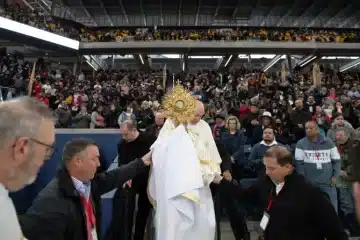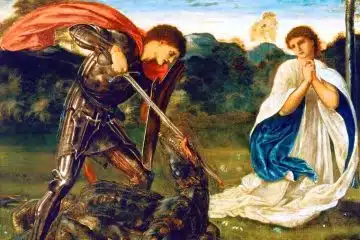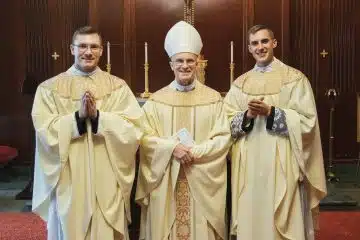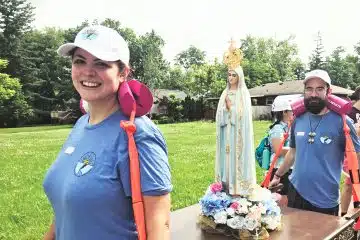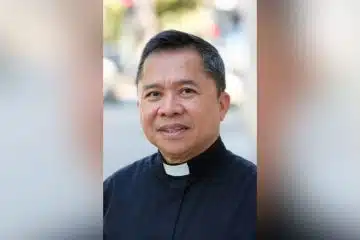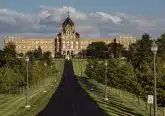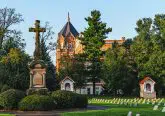Historic St. Aloysius commemorates 150 years
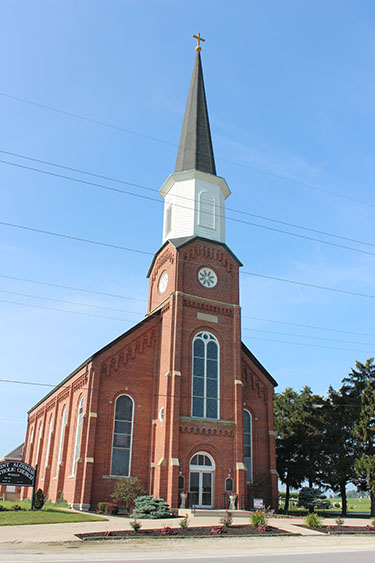
By Sarah Anne Carter
For The Catholic Telegraph
Designated a historical landmark in 1979 as part of the “Cross-Tipped Churches,” St. Aloysius in Carthagena commemorated its 150th anniversary in June.
The parish building dates back to 1878, but the congregation can date itself back to 1865.
“Saint Aloysius is certainly unique in its African-American origins,” said Precious Blood Father Tom Hemm, pastor of the St. Henry Cluster Parishes. The cluster includes four other parishes along with St. Aloysius. “The original community of Carthagena, Ohio, was formed by former slaves who had been emancipated after the Civil War. The original cemetery that borders the parish cemetery reverences the remains of many who immigrated to this region from Virginia once released from slavery. When I arrived, I observed the African St. Perpetua in one of the glass windows and St. Peter Claver evangelizing slaves in the slave trading center of Carthagena, Colombia, honoring the African connection of the original community.”
Before the parish building was built, Catholics attended Mass at St. Charles Seminary and the first recorded baptism was in September 1861. In 1865, there were 15 families registered as part of the parish. As the parish grew, the decision was made to construct its own church building in 1875.
According to the church history, “Controversy started immediately, and it centered on the location of the church. Many parishioners wanted the church to be built a half mile west of its location today on land that was to be donated by a member of the parish. Other parishioners wanted the church to be built closer to St. Charles Seminary. Since neither side wanted to give in, Father Henry Drees determined that the church would be built on the 1.5 acres that St. Charles would donate. Today, the location seems to be a minor issue, but in 1875, people walked to church, and the location was a very serious matter. Despite controversy over location and financing the building project, the church was built in the years 1877-78.”
The church was dedicated June 30, 1878. The building has gone through several renovations in its history but the original stained glass windows remain, along with the bells in the bell tower, two paintings, the Stations of the Cross and statues of St. Aloysius, St. Monica and St. Rose of Viterbo.
St. Charles Seminary is now a retirement site for aging Missionaries of the Precious Blood and a few diocesan men, with plans to open it up to lay people, too.
“This parish is in intimate relationship with this missionary community being a neighbor for 150 years,” Father Hemm said. “In one sense the parish was born from the seminary community in that place. To this day, many parishioners serve on the staff of St. Charles Center and have long term friendship with the residents there.”
The church also continues to have ties to Africa, as Precious Blood Father Benedict Magabe, from Tanzania, served there from 2008-2013.
“The awareness of parishioners has been broadened over the past several years while served by Father Benedict, a missionary from Tanzania. It was a unique experience to deepen our understanding of the relationship of our country with Africa today,” Father Hemm said. “Many members of the community have been supportive of the Precious Blood mission in Africa. Some parishioners have visited Africa over the years and have taken interest in the Precious Blood mission there.”
The parish celebrated its 150th anniversary June 21.
“It was a very beautiful celebration as Bishop Joseph Binzer concelebrated the Mass along with our present and past parish pastors and other religious members of St. Aloysius Parish,” said Nancy Wuebker, whose husband’s family history with St. Aloysius goes back to 1885. “After the Mass, everyone went to the St. Gasper Room at St. Charles Living Center to enjoy a wedding style dinner and we ran a 30-minute video during the meal which included pictures from the past to the present. A history book of St. Aloysius Parish that was compiled by a group of committee members was for sale along with a commemorative memento of the image of our church on an ornament/sun catcher.”
Father Hemm participated as a concelebrant during the Mass.
“The celebration was a wonderful occasion to renew acquaintance with the extended families of current parishioners,” Father Hemm said. “Many of these are active participants throughout Saint Henry Cluster and beyond. I believe that the celebration gave all of us a greater appreciation of the fuller Catholic community beyond the immediate parish family of today. The Mass was celebrated particularly for the living and deceased members of the parish and reactivated our gratitude for the multitude who have contributed over the years to the vitality of this parish. “
While sharing a priest among five parishes lends itself to challenges, the St. Aloysius parish tries to focus on what it can do. Among its ministries is weekly adoration and having an active prayer life. Father Hemm said, “The limited service of an aging pastor who is serving four other parishes has stimulated the community’s awareness of its own mission to evangelize.”
“The parish and the community are very closely intertwined,” Wuebker said. “Within a small parish everyone knows everyone and he or she is needed and wanted. It takes the cooperation of everyone to accomplish our goals. We are very proud of our small parish in this rural, farming community and wouldn’t have wanted to raise a family anywhere else. Even with the priest shortage, we still feel we have a bright future as young families are moving into our parish plus we have a strong drive to keep our parish open. Our church is a huge part of our faith, our history, and our traditions.”
This story originally appeared in the August 2015 print edition of The Catholic Telegraph.



